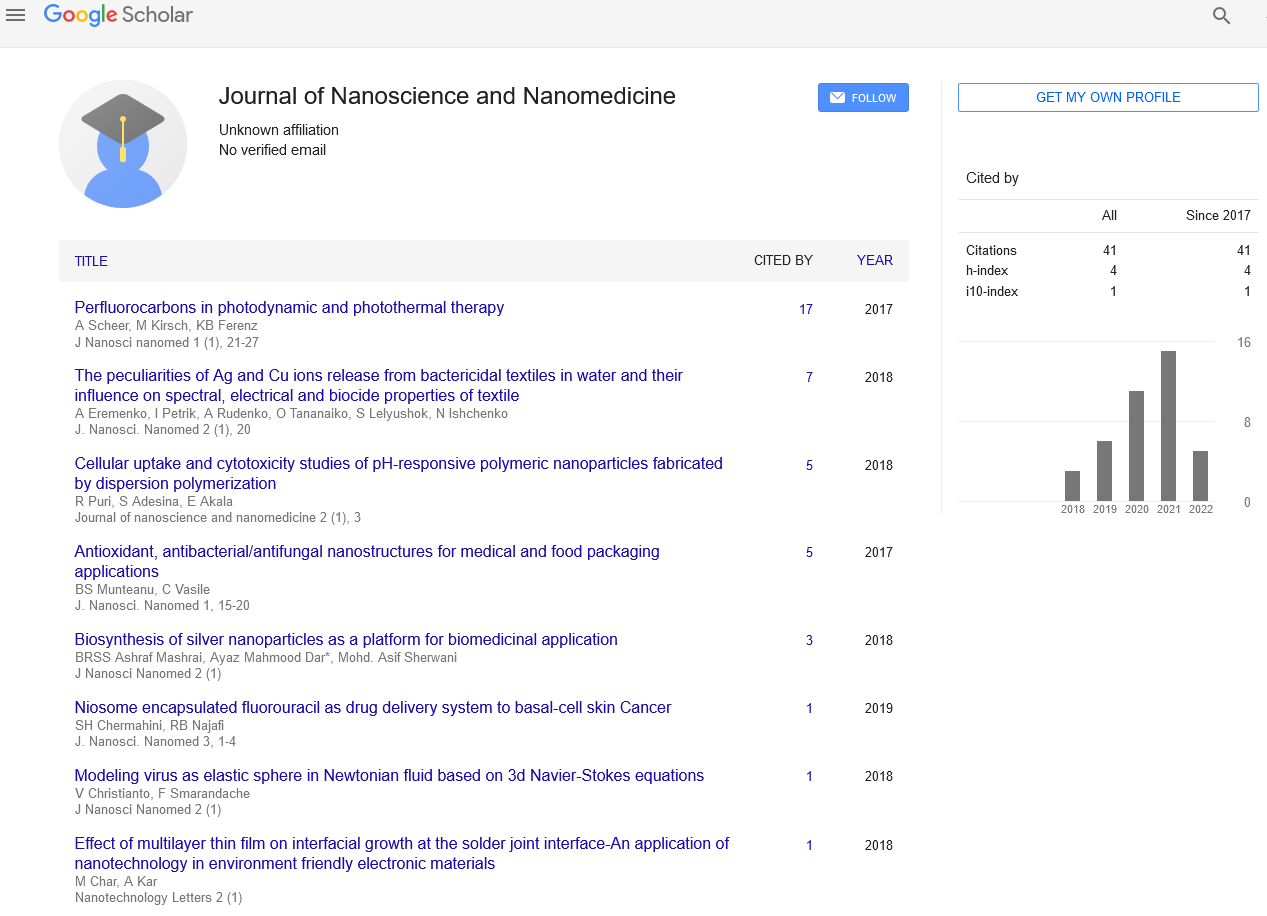Rheology of Nanofluid Behavior During Convection in Pipe
Received: 07-Sep-2022, Manuscript No. PULJNN-22-5817 ; Editor assigned: 09-Sep-2022, Pre QC No. PULJNN-22-5817 (PQ); Accepted Date: Sep 29, 2022; Reviewed: 18-Sep-2022 QC No. PULJNN-22-5817 (Q); Revised: 27-Sep-2022, Manuscript No. PULJNN-22-5817 (R); Published: 30-Sep-2022, DOI: 10.37532/puljnn.2022.6(5).1-2
Citation: Griffith J. Rheology of nanofluid behavior during convection in pipe. J Nanosci Nanomed.2022; 6(5):01-02
This open-access article is distributed under the terms of the Creative Commons Attribution Non-Commercial License (CC BY-NC) (http://creativecommons.org/licenses/by-nc/4.0/), which permits reuse, distribution and reproduction of the article, provided that the original work is properly cited and the reuse is restricted to noncommercial purposes. For commercial reuse, contact reprints@pulsus.com
Abstract
The behaviour of several variables on nanofluid flow is discussed, along with a simulation of nanofluid flow in a pipe. Al2O3-water was simulated as a nanofluid with an Al2O3 volume fraction ranging from 2% to 8%. Viscosity, temperature difference on wall, Reynolds number, thermal conductivity, and pipe temperature are all calculated for the simulation using the single phase approach. The finite difference method is used in the MATLAB code to solve the pipe flow problem. Finally, a simulationbased conclusion is reached and reports on how the temperature of the nanofluid flow altered with its axial and radial directions. Based on the current simulation, it is possible to explain how changes in thermal conductivity, temperature differential on the wall, Reynolds number, and the viscosity of the nanofluid with pipe length. Additionally, the radius of the pipe, the exterior temperature of the wall, the Reynolds number, and turbulent flow have an impact on the heat transfer through the pipe.
Key Words
Atherosclerosis; Nanoparticle
Introduction
In industrial processes, liquid thermal characteristics are crucial for both cooling and heating applications. A liquid's thermal conductivity is a crucial physical characteristic that affects how well it transfers heat. Because of their limited thermal conductivity by nature, conventional heat transfer fluids are unsuitable for high cooling applications. Using solid additions and the traditional effective medium theory for effective properties of mixes, scientists have attempted to improve the intrinsically low thermal conductivity of these conventional heat transfer fluids.
Due to drawbacks like still low thermal conductivity, particle sedimentation, machine component corrosion, particle clogging, excessive pressure drop, etc., attempts to fine-tune the dimensions of these solid suspensions to millimetre and micrometre ranges to improve heat transfer performance have failed. A fluid containing nanoparticles, also known as nanoparticles, is referred to as a nanofluid. Engineered colloidal suspensions of nanoparticles in a base fluid make up these fluids. Typically, metals, oxides, carbides, or carbon nanotubes are employed as the basis for the nanoparticles in nanofluids. Water, ethylene glycol, and oil are examples of typical base fluids.
In many heat transfer applications, such as microelectronics, fuel cells, pharmaceutical processes, hybrid-powered engines, engine cooling/vehicle thermal management, domestic refrigerators, chillers, heat exchangers, grinding, machining, and lowering boiler flue gas temperatures, nanofluids have novel properties that make them potentially useful. Compared to the base fluid, they have improved thermal conductivity and the convective heat transfer coefficient. It is discovered that choosing whether nanofluids are suitable for convective heat transfer applications requires a thorough understanding of their rheological behaviour. Numerous authors have used simulation to describe the impacts of nanoparticle concentrations, diameter, materials, and Reynolds number in diverse flows in circular and rectangular pipes in two and three dimensions.
The impacts of thermal fields, type of nanofluids, nanoparticle volume fraction of nanofluids, and aspect ratio. Nanofluids can be taken for single phase fluids in analyses like Computational Fluid Dynamics (CFD). However, two-phase assumptions are used in practically all recent academic works. It is possible to use the traditional theory of single phase fluids, in which the physical characteristics of the nanofluid are viewed as a function of the characteristics of both the constituents and their concentrations. Numerous numerical studies have been done on the convective heat transfer of nanofluids utilising different kinds of base fluids and nanoparticles.
Because wall temperature is taken into account to be a constant value, the water-steel-water heat transfer coefficient is assumed to be a constant. Since laminar flow is taken into account in this work, the convective heat transfer coefficient is referred to as having a constant value.
Water-based Al2O3 with particles that have a mean diameter of 25 nm and a volume of 2%-10% Al2O3. A constant temperature has been applied to all of the walls. The flow has a circular cross section and is totally laminar. A 50°C temperature is maintained within as the nanofluid is introduced. The centre axis of the temperature profile is uniform. The temperature profile in a pipe with respect to diameter and length at 2% nanoparticle volume friction. The nanofluid's initial inlet temperature is constant, but as soon as it enters the heating zone, the temperature rises. Due to the fast rate of temperature growth, thermal conductivity initially increases quickly before decreasing. The viscosity profile of a nanoparticle in a pipe at 2% to 10% volume friction. The temperature profile is consistent along the axis.
The radius of the pipe influences viscosity and thermal conductivity significantly. The temperature difference on the wall is initially increased at a rapid rate, which is then reduced. The viscosity decreases as the outside temperature rises. The thermal conductivity of a pipe increases as its outer temperature rises. The thermal conductivity decreases as the Reynolds number increases. The apparent viscosity increases as the Reynolds number increases, resulting in a decrease in thermal conductivity.





